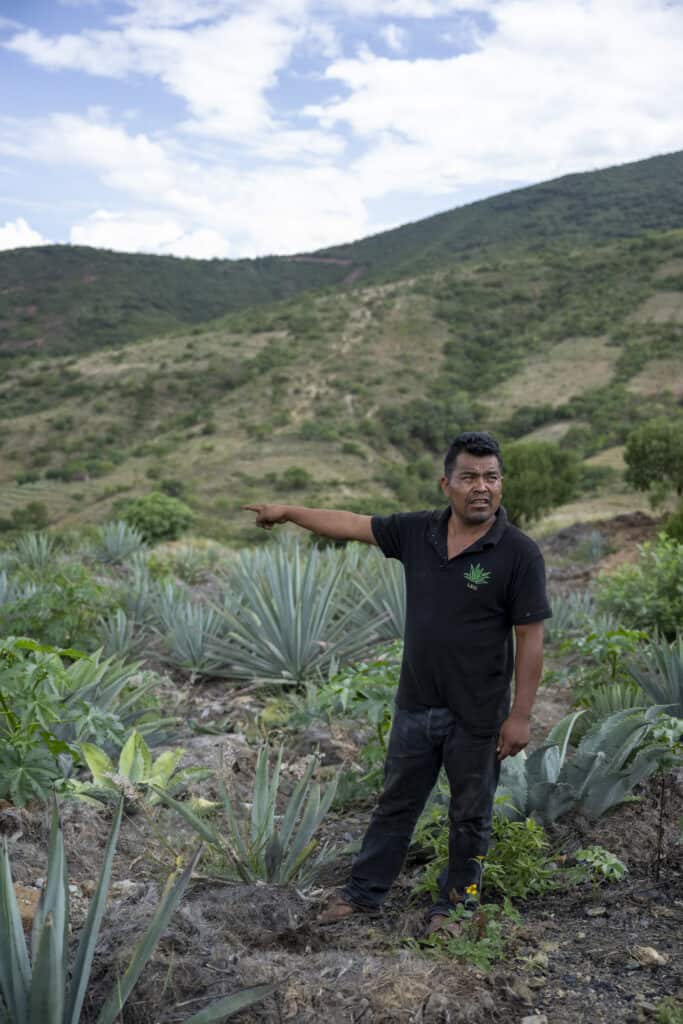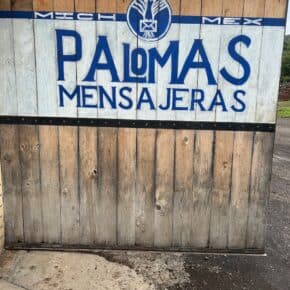Grulani is a new mezcal brand to the US with distinctive bottles and labels which reflect a keen design sensibility. The mezcal inside the bottles comes from an equally distinct heritage filtered through Leo Hernández’s ideas about distillation. It’s been in Europe for a bit but is now relaunching in the US.

Grulani means “fire in the mouth” and was created by Hernández in 2016. He later started working with Victor Moreno Santos who manages the brand side of the equation. They co-own the brand 50/50 and have been selling in Spain since 2019 where they are featured in the El Corte Ingles chain. COVID hampered their initial US launch so they are relaunching in the US this year with seven constant single agave labels and two rotating special editions annually.
Growing up in the business
Hernández comes from generations of mezcaleros and much of his family either distills or is involved in the business. Based in San Baltazar Guelavila, Oaxaca, he learned his trade starting at eight years old when his father had him working in the palenque tending the burros as they carried the agave in from the fields or churning the tepache. He remembers trying to lift agaves before he was big enough to manage the weight. He started distilling when he was just 14. Today he’s 39 which means that he’s been distilling for 25 years, more than half his life. He told me that “I was born in mezcal and I’ll die in it. It’s a heritage.”
Hernández’s approach
Hernández has a really distinctive approach to distilling: He distills exclusively single agave mezcals. There are no ensambles in his impressive line of seven labels which is a real break with tradition. I’ve always been told, and it certainly seems true from everything I’ve been able to gather from oral testimony an other historical research, that traditionally mezcal was made from whichever agaves were ripe at the same time. So, traditionally, mezcal was always an ensamble. Of course, one of the major trends in mezcal in this century has been a move to single agave. There are many reasons but for Hernández it’s about focusing on the differentiation between agaves and really focusing on their unique identities and adapting his distilling technique to the agave.

We talked a bit about Lumbre which is an agave that really excites him. He says that only two other producers are making it, he is really focused on expressing the flavors that come from an agave like it. But Hernández’s voice really rose in excitement when describing how he managed the distillation of this year’s two special editions, a Jabalí and a Coyote.

Jabalí is famously difficult to distill because of the high proportion of saponins in the agave. The word sounds like soap because they’re related and the outcome in the distillation process is similar. Usually Jabalí foam up during fermentation and distillation which can overflow the fermentation tanks and stills. It takes a ton of time and attention which, aside from the low agave to mezcal yield, are some of the reasons why we don’t see more of it out there.

Hernández told me that when he was making this Jabalí that it foamed up during the tepache, or fermentation and again during distillation when the foam went up the serpentine. The first distillation pass, or ordinario, yielded only 300 liters from one ton of agave. The ABV was also much lower than usual: Hernández usually gets to 25% ABV after the first distillation of Espadín but his Jabalí was only at 15% ABV after that initial distillation run. He says that the first run was orange, the second looked like a reposado, and only after the third distillation run did it run clear.

Brand identity
Grulani’s physical appearance has its own distinctive aesthetic. The bottles are squat and oblong while each agave is represented by a different symbol. Special editions are even presented with wooden bases. It’s a beautiful presentation that reminds me of projects that Felix Monterroza has done with Cuishe. It’s really fantastic to see this idea being met with an equally high quality mezcal in the bottle.

Victor Moreno Santos is responsible for this side of the brand and has obviously lavished attention on everything from bottle to website. Both he and Hernández are really excited about presenting the mezcal this way. Santos says that “we tried to represent the Zapotec culture with our bottle so we thought elliptical bottle” and made the connection with Mexico’s strong tradition of symbolic representation, of using symbols and colors to communicate information. He says “we created kind of alphabet with colors and symbols so that we could create every expression and label.”
Suffering through the current era
Despite being a half owner of the brand, Hernández talked quite a bit about the mechanics of the business and what they mean for him and his community. His brothers are all mezcaleros who distill on contract for other brands. That business choice is very common. Hernández is really the outlier because he created his own export brand. His goal is to focus exclusively on Grulani moving forward. In the past he’s worked for many others like Rezpiral, Convite, Koch, and Pierde Almas.

Recently more mezcaleros have been breaking into the equity side of the business. The potential there is fantastic because it gives the mezcalero and the entire community of interests around him or her a bigger stake in the outcome of the brand. Of course the other business isn’t going away, if anything it’s only scaling right along with the entire mezcal business and has to account for the vast majority of mezcal produced. No matter how the mezcal is labeled, most of it is still produced as part of this larger supply chain.

One of the most interesting things that Hernández mentioned was that he recently received a visa to the United States. He said that he wants to come see how his mezcal is sold and help with that process and, indeed, he was recently able to visit New York City. I’ve heard a number of mezcaleros say exactly the same thing recently which is a real shift, they are no longer interested in coming to the US to work here, they want to visit in order to build their businesses by meeting the people who buy their bottles and help sell more of it. Along the way the complex dynamic of producer and consumer will have to create some form of feedback loop that will change mezcal even further. Hopefully, as with the case of Grulani, the maker will be able to own and participate in that process.
Be sure to check out the tasting notes for the Grulani expressions.












I consider the phenomenon that producers have shares (not exclusive ownership, that would be something completely different!) to be difficult, because it means for the producer to invest his resources (labor, access to land, know-how, etc.) in a brand on whose success on the sales market he has no influence. Because the “white” partners continue to operate there. If they fail, the producer can do little, but is involved and cannot leave the brand – unlike in the earlier constellation of “contract distillery”. It remains to be proven that this constellation is not just a new Trojan horse for traditional producers!